|
|
Post by codystarbuck on Feb 15, 2024 1:27:11 GMT -5
What If...? #4 Creative Team: Creative Team: Roy Thomas-co-plot, script & editor, Frank Robbins-co-plot and pencils, Frank Springer-inks, Joe osen and John Costanza-letters, George Bell-colors Synopsis: Our tale begins with a retelling of how Cap & Bucky confronted Baron Heinrich Zemo, as he sought to steal a remotely piloted drone plane, for some reason, despite the Germans already having more advanced drone weapons, like the X-Glide bombs, and the V-1 and V-2 rockets. Zemo activates a giant pink android (don't ask) and Bucky ends up clobbered and Cap gets zapped, while distracted. They are tied to the aircraft, which is programmed to fly to Berlin (quite a range, for something that size, at a British depot) but some kind of time paradox frees them, as a ghost vision of Cap's shield severs their bonds. The plane takes off and they chase with a motorcycle and Bucky grabs onto it and is blown to tiny decoy pieces (until he gets better, later) and Cap is blown into the North Sea, where he is frozen in carbonite...er, ice, and floats around for a bit, before being found by eskimos/inuits, who worship him as a totem, even though that doesn't gel with their traditions. The Watcher thinks this is pretty sad and takes that thought to an extreme..... 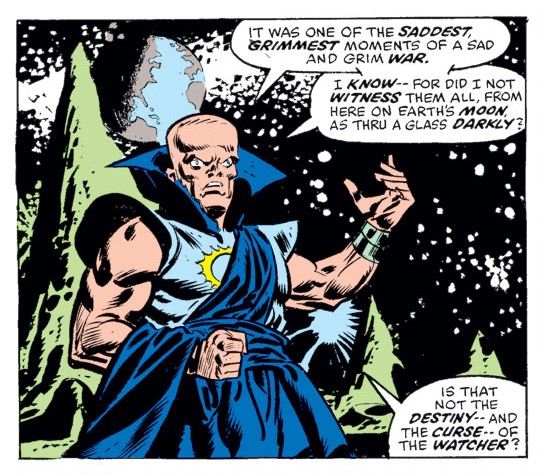 Saddest part of the war? I can think of about 12 million reasons that is not true, not counting the dead of the battlefield. Anyway, Th Watcher drones on about The Human Torch and Toro leading the Allied vanguard into Berlin and burning his way into the Fuhrerbunker, where Eva Braun has already poisoned herself and Adolf Hitler has a Luger pointed at his head, despite it being Walther PPK, based on eyewitness testimony of the body and the pistol laying at Hitler's feet. 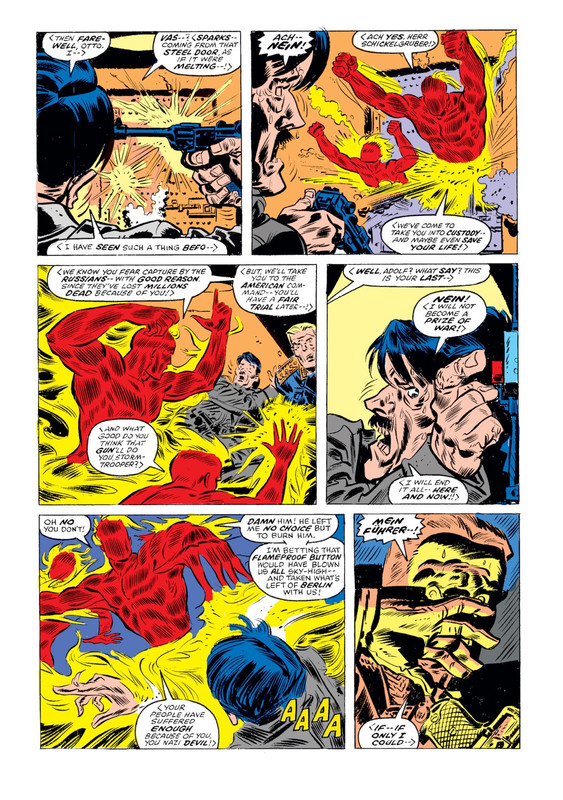 Hitler goes for a detonation switch, for some doomsday weapon and Torch flames him in the face and body and der Fuhrer becomes a charcoal briquet. Namor is in the Pacific, swinging Japanese mini-subs around and knocking torpedoes aside. Union Jack & Spitfire are in London, preventing people from throwing grenades at Churchill, who might be German agents, though they could have been members of the Labour Party. Probably Germans. The Brits get summoned to the Westminster Clocktower and the secret meeting room, behind Big Ben, where Major Rawlings informs the remaining members of the Invaders of the deaths of Captain America and Bucky. The Yanks (and Namor) are ordered home and the Brits watch over home. At the White House, Namor's flagship is met by Secret Service with itchy trigger fingers, and then Harry S Truman, who probably swore at the Secret Service guys. He brings the strangely dressed bunch into the White House and announces that captain America and Bucky will live on.... 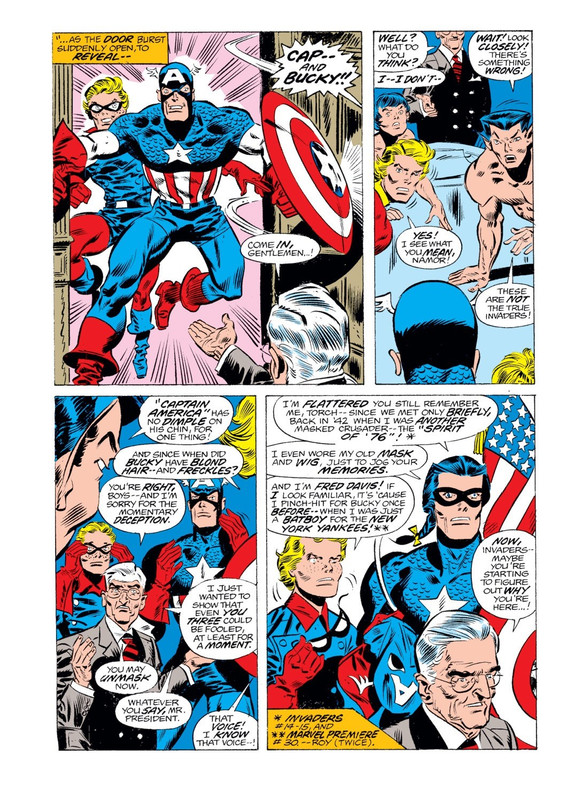 ...in the form of The Spirit of '76 and Fred Davis, batboy for the New York Yankees, who helped out the Invaders and Liberty Legion, when Red Skull put a whammy on them. Slight problem with Fred's hair color and freckles, though. They are further told that Miss America and The Whizzer are joining the team (and they burst into the room) and they are then shipped out to the Pacific, where they aid in hitting Japanese defenses in the island hopping campaign, knocking down kamikaze pilots, and generally being a nuisance to the Empire of Japan, until an OMD song hits the scene.... The Japanese surrender and Gen MacArthur becomes convinced he is God and the Invaders are brought back home and renamed the Mostly-Winners-Squad. They smack around some crooks and then take a sabbatical, during which the Torch takes Toro home to meet his father, Prof Phineas T Bar...er, Horton (did he hear a Who?), who has an iron handshake....  ....possibly because he is an android. They then meet his latest creation... 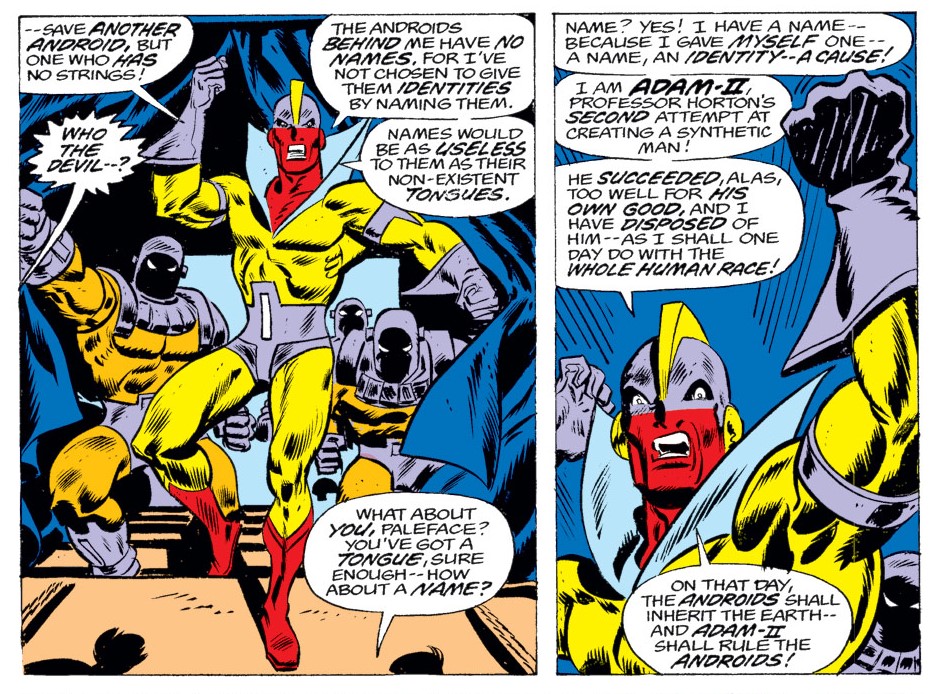 Adam II (ancestor of Adam-12). He is a new synthetic man and he plans to rule the organic men with androids, while he rules the androids. Torch and Toro attack the androids, but they are fireproof and it was all an ambush, as they fall into a watery trap and end up in a chamber, with the real Prof Horton. Adam floods the chamber and leaves them to die, while he goes off to kill a Democratic candidate for the US Senate, from Boston. Torch flames the non-soaked part of his body and sets off a fire alarm, which just happens to draw the ex-Liberty Legion hero, The Patriot, who was in the neighborhood, deflating footballs. He rescues them..... 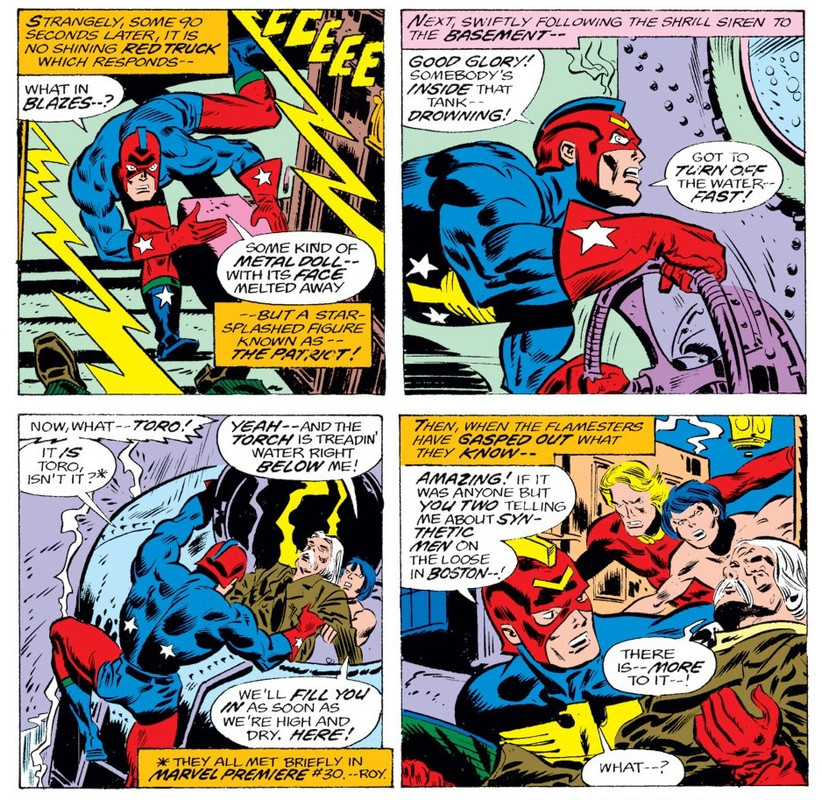 ...and they link up with the Majority-Winners-Squad and then fan out to protect Democratic candidates from the androids. One of them is some pretty boy son of an ambassador and a war hero, named Jack...... 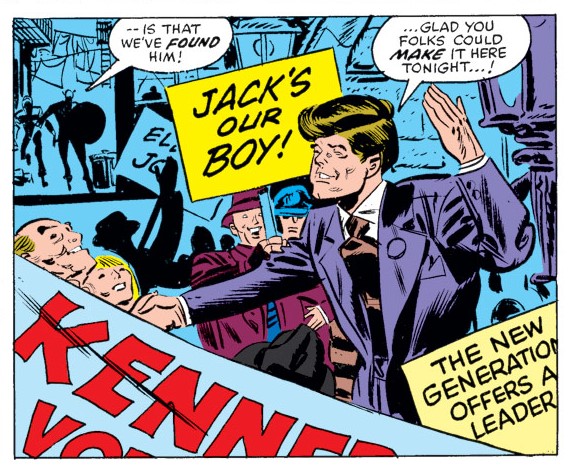 Cap & Bucky run into Adam & the Androids (cool name for a band) and their Robot Kennedy. The fight and Cap is badly hurt, but gets away and climbs the tower of the Old North Church, to signal the More-Than-A-Couple-Of-Winners-Squad, and is attacked from behind. He flashes "One if by Robot," then dies.  His summons draws the team, including Miss America, who is fresh from the optometrist's, and they rescue Lt Kennedy from the androids. Then, Cap arrives to block Adam from punching Jack. Adam tries to flee in a car and spins out on the lubricant oozing from the destroyed androids and crashes and burns. Jack thanks the Three-Or-Four-Winners-Squad and then they confront Cap and learn that he is The Patriot.... 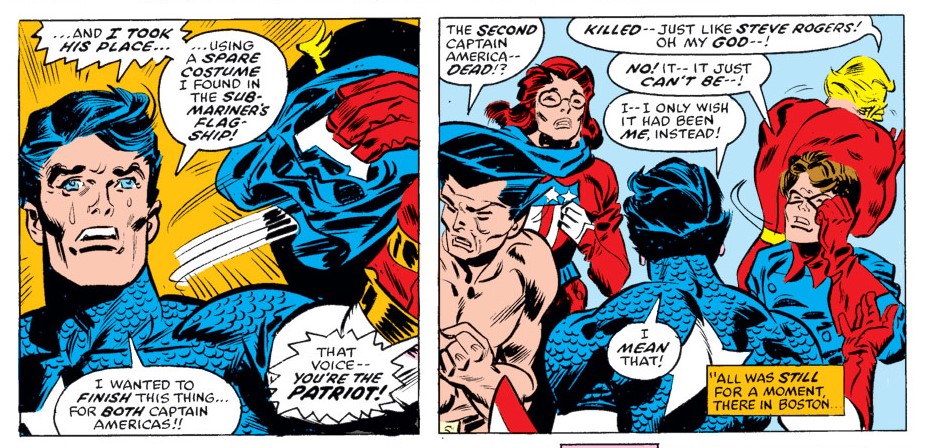 They continue on as the Quorum-Of-Winners-Squad, until they break up, over artistic differences and release solo albums, which are panned by the critics and they fade into obscurity. Thoughts: What If...? was supposed to be alternate history; but, this issue became actual continuity, to explain away the post-war appearances of Captain America, before the 1950s, when 50s Cap, established by Steve Englehart, turned up, smashing Commies, though with a rather loose definition of the ideology that included minorities and anyone who disagreed with either him or Joe McCarthy. That is, until Edward R Murrow takes 50s Cap down With his pointed Person-to-Person expose of Cap's Right-Wing ideology and he is censured by SHIELD and stuck in a freezer, until the 1980s, when the Reagan Administration made it safe to call people Pinko Liberals, again. Anyway, the conceit is that the Captain America seen through the late 1940s is none other than The Spirit of '76, the former member of the Crusaders, the band of heroes who were duped by Alfie, the German agent, in a plot to murder King George the VI. His sidekick is Fred Davis, the Yankee batboy who aids Bucky in assembling the Liberty Legion and defeating the Red Skull. The Spirit is willing; but, his flesh proves weak and he is killed and replaced by The Patriot. Obviously, as the concept gets further watered down, the government decides to get rid of the Patriot, before he does something foolish, like add a girl sidekick. All things considered, this is a pretty good tale and not a bad continuity fix, allowing both the Timely past and the Marvel present, even if it starts to seem like everyone got a turn in Cap's uniform. Using Prof Horton to introduce a new synthetic baddie works pretty well and Adam kind of points the way to Ultron and The Vision, down the road, right down to red skin. It's nice to see Frank Robbins on this, as he really makes the story feel like the 1940s, unlike his successors on the Invaders series. My only quibble is that Roy forgot to tell him to draw the Walther, instead of a Luger, in Hitler's hand. The Torch, who go to be a bit of a sad sack, in the Invaders, gets to flash-fry Herr Schicklegruber, which would have been just deserts for the maniac. As it is, he failed to burn up the head and it was preserved in a jar. What If...? #5 had a different story, of Captain America surviving WW2, which was a true alternate history, where he continues on, for a few years and Bucky becomes head of SHIELD, after Nick Fury's death. Then, after a battle with the Hulk, he forces an aging Cap to step down and Bucky replaces him, with Rick Jones as the new Bucky and Steve Rogers heading up SHIELD, which sounds like something to revisit, down the road, possibly after Bucky defects to Puerto Rico. Next up, a look at Namor's post-war adventures, before he ends up in the Bowery, and a look at what happened to the Human Torch and Toro. After that, the return of Baron Blood. Next, a look at the return of the Invaders, after a fashion, in the pages of Avengers West Coast and Namor. That will be followed by Roy Thomas' return to the Invaders, with a new mini-series and some new foes. I also intend to look at the Midnight Sons use of The Blazing Skull, which tread on Invaders territory. After that, I will jump way ahead, to The Marvels Project, as Ed Brubaker messes with continuity, a little, then The Patriot mini-series, showing what happened to him and his time as Captain America. I do not plan on looking at New Invaders, as that is a whole new bunch of people, latching onto the past. Nor do I intend to look at the revival of Toro. I chose marvel's Project, because it reflects closely on Invaders continuity and The Patriot, because it also closely ties into the What If...? post-War revision; but, I am less interested in later uses of the characters, as they got more and more watered down. Maybe a look at Citizen V, as he pops up in Thunderbolts. We will see. Basically, I am skipping New invaders because of the likes of Chuck Austen, and the further we go in this, the less it feels like Roy Thomas' baby and the less interest I have in the modern uses. I might look at the Young Allies mini-for the heck of it.
|
|
|
|
Post by aaronstack on Feb 15, 2024 22:17:46 GMT -5
'I even wore my old mask and wig, just to jog your memories' Nice catch, Roy  |
|
|
|
Post by Prince Hal on Feb 16, 2024 22:59:28 GMT -5
The Robbins-Springer Watcher just wants to serve man...  |
|
|
|
Post by zaku on Feb 17, 2024 7:09:02 GMT -5
I got lost for a moment: why was it necessary to put a "transition" Cap between Steve Rogers and Patriot?
|
|
|
|
Post by aaronstack on Feb 17, 2024 20:36:35 GMT -5
I got lost for a moment: why was it necessary to put a "transition" Cap between Steve Rogers and Patriot? It's not a 'What If..?' ish unless at least one person dies  |
|
|
|
Post by codystarbuck on Feb 17, 2024 22:21:32 GMT -5
I got lost for a moment: why was it necessary to put a "transition" Cap between Steve Rogers and Patriot? It's not a 'What If..?' ish unless at least one person dies  I think Roy's intention was to cover the period established as when Cap disappeared (sometime between late 1944 and early 1945) and the end of the actual publication of Captain America Comics, in 1949. The Spirit of '76 covers the rest of the war, to the two published All-Winners Squad stories. The Patriot then covers 1946-1949, when Cap's series was cancelled. 50s Cap then appears and covers the brief time frame of the Timely hero revival. The Virtues of Captain America blog make a good case for why Roy felt he needed both the Spirit of '76 and The Patriot. The Patriot was still appearing in Marvel Mystery Comics, until issue #74, in 1946. The two All-Winners Squad issues (#19 and 21, with no issue #20) were also in 1946. So, Patriot would have been busy, hence Spirit of '76 getting the job, for the rest of 1945 and most of 1946. The Patriot picks up the mantle, his series is cancelled, but he continues, as Cap, until 1949, when that series ended. Then, Steve Englehart's 50s Cap (the first retcon to explain post-war Captain America stories) appears to coincide with the brief revival, in 1953. In Captain America Annual #6, JM DeMatteis explainds that Jeff Mace, The Patriot, continued for a few years. Fred Davis, the new Bucky, was injured and Mace teamed up with Golden Girl (different from the Invaders Golden Girl), until 1949, as in those later comics. However, with the war over and "...the spectre of Communism had yet to darken our land...," Mace retired as Cap and continued on with his career as a newspaper reporter, explaining the gap until the 50s Cap appears. It's all kind of convoluted, but you can blame Roy's obsessive need to adhere to the publication of the characters, in the time frame they existed, originally. Thing is, he would break those rules, from time to time; but, didn't here. The Patriot got a mini-series, in 2010, (Captain America: The Patriot) which told his story, as Cap, from start to finish, plus his origin and time as The Patriot, before assuming the mantle of Cap. It's a pretty good mini, written by Karl Kesel. I plan on covering it. This kind of has me revising my plans. At this point, The Invaders are done and Roy has done a retcon, via What If...?, of the post-War Cap stories. The next phase will be to look, chronologically, at the various retcons to link the 1940s Timely to the 1960s Marvel. So, I will look at the Saga of the Sub-Mariner and The Saga of the Human Torch, for their linking stories (not the whole mini, in either case), and how they tie in to their Marvel revivals. I will probably also cover Steve Englehart's creation of the 50s Cap, though it took place before Invaders was launched; but, why not? I also want to cover Cap's modern battle with Baron Blood. Then, I will look at the 90s Invaders mini-series, from Roy, where they fight new foes, based on defunct 1940s characters. Then, a look at post-War adventures for those specific characters who weren't exactly revived, like the original Torch, plus Master Man and Warrior Woman, in Namor, plus Spitfire and Union Jack. Then , Ed Brubaker et al's further modernizing and streamlining of The Invaders, via The Marvels Project and Captain America: The Patriot, plus, maybe the Young Allies mini. I will also cover the Blazing Skull story, from Midnight Sons, and the return of the original Citizen V (or, rather, his legacy), from Thunderbolts. Still not gonna cover New Invaders, since that is just the name, with new heroes, in the modern day and I don't really consider it the same thing. I'm on the fence about the revival or Toro, after he was killed off and I don't see much reason to do Avengers/Invaders, since it rehashes the Avengers story; but, maybe....if I feel motivated. Mostly, I want to keep to either Roy Thomas' material or the official Golden Age Timely heroes, tied to The Invaders or Liberty Legion, or Roy's use, like in the Kree-Skrull War. I might use this to look at Joe Straczynski's The Twelve, since it covers similar territory, though I think it falls apart, halfway in (partially thanks to the delays in publication). If I were insane, I might turn this into an exploration of the Timely Era, the Atlas Era, and the dawn of Marvel, as established under the Marvel continuity; though that makes for messy structure to things. |
|
|
|
Post by zaku on Feb 18, 2024 6:12:14 GMT -5
It's not a 'What If..?' ish unless at least one person dies  I think Roy's intention was to cover the period established as when Cap disappeared (sometime between late 1944 and early 1945) and the end of the actual publication of Captain America Comics, in 1949. The Spirit of '76 covers the rest of the war, to the two published All-Winners Squad stories. The Patriot then covers 1946-1949, when Cap's series was cancelled. 50s Cap then appears and covers the brief time frame of the Timely hero revival. The Virtues of Captain America blog make a good case for why Roy felt he needed both the Spirit of '76 and The Patriot. The Patriot was still appearing in Marvel Mystery Comics, until issue #74, in 1946. The two All-Winners Squad issues (#19 and 21, with no issue #20) were also in 1946. So, Patriot would have been busy, hence Spirit of '76 getting the job, for the rest of 1945 and most of 1946. The Patriot picks up the mantle, his series is cancelled, but he continues, as Cap, until 1949, when that series ended. Then, Steve Englehart's 50s Cap (the first retcon to explain post-war Captain America stories) appears to coincide with the brief revival, in 1953. Well, he could have kept the Spirit of '76 until the 1950s Cap, right? There were no valid reasons to have him killed. Oh well, it's not important  Thanks for the explanation! |
|
|
|
Post by codystarbuck on Feb 18, 2024 11:16:10 GMT -5
I think Roy's intention was to cover the period established as when Cap disappeared (sometime between late 1944 and early 1945) and the end of the actual publication of Captain America Comics, in 1949. The Spirit of '76 covers the rest of the war, to the two published All-Winners Squad stories. The Patriot then covers 1946-1949, when Cap's series was cancelled. 50s Cap then appears and covers the brief time frame of the Timely hero revival. The Virtues of Captain America blog make a good case for why Roy felt he needed both the Spirit of '76 and The Patriot. The Patriot was still appearing in Marvel Mystery Comics, until issue #74, in 1946. The two All-Winners Squad issues (#19 and 21, with no issue #20) were also in 1946. So, Patriot would have been busy, hence Spirit of '76 getting the job, for the rest of 1945 and most of 1946. The Patriot picks up the mantle, his series is cancelled, but he continues, as Cap, until 1949, when that series ended. Then, Steve Englehart's 50s Cap (the first retcon to explain post-war Captain America stories) appears to coincide with the brief revival, in 1953. Well, he could have kept the Spirit of '76 until the 1950s Cap, right? There were no valid reasons to have him killed. Oh well, it's not important  Thanks for the explanation! Valid? No; just Roy's need to stick to the chronology of the published comics. He wanted The Patriot, since he was a Timely character, relatively popular, and a logical choice. However, since he still had his own series going, until 1946, Roy felt bound by that and needed someone in between, especially someone who could have a shocking death. He could have stuck with the Spirit and killed him off in 1949; but, he still wanted to use The Patriot.. |
|
|
|
Post by codystarbuck on Feb 20, 2024 2:17:09 GMT -5
So, we all know what happened to Captain America, at the tail end of the war.....  Which led to....  and, then...... 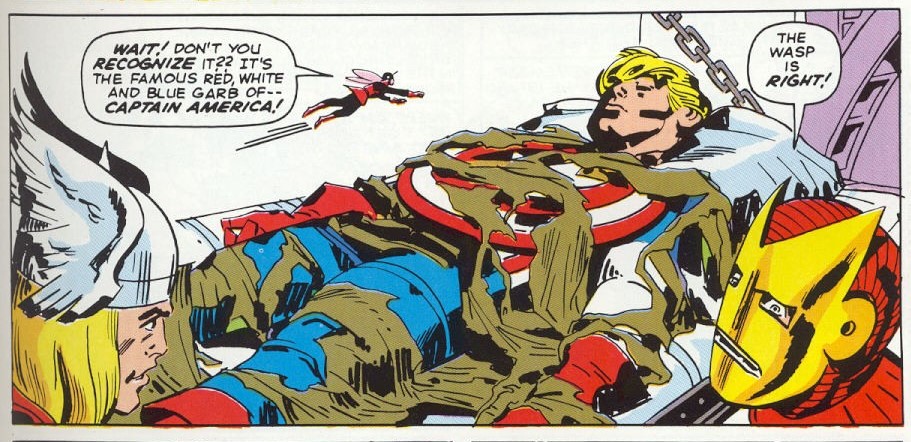 From there, Cap had to learn about a new world and funky aliens, who look like vegetables.....  Aside from constantly whining about Bucky, he adjusted. He would hang out with the Avengers, have solo adventures, fight alongside SHIELD, face his old foe, The Red Skull (and a few other Nazis, like Baron Zemo, Arnim Zola, and Red Skull bunch of Nazi Nitwits) and some other baddies Rick Jones took over, briefly, as a new Bucky, but that didn't stick for long. Now, What If...? #4, established that, while Steve Rogers was napping inside an ice cube, William Nashlund, aka The Spirit of '76, became the new Captain America, at the request of the government and President Truman. He died battling Adam II's androids and Jeff Mace, aka The Patriot took over the role, and continued in it until 1949. Captain America Annual #6 reveals that he gave it up as their seemed little need for a symbol, with the war over, and the Red Menace yet to darken our door, despite John Steinbeck's The Grapes of Wrath being attacked as being Communist, in the 1930s and Henry Fonda being denied an Oscar, in favor of Conservative Jimmy Stewart, for The Philadelphia Story, or The House Un-American Activities Committee being formed in 1938, to root out Reds Under Beds (the little known Dr Seuss book) or the Soviet Union testing their first Atomic Bomb, in 1949. Apparently, daily news reporting was more important. However, in 1972, before Roy ever decided to make the cover to USA Comics into a reality, with The Invaders, Steve Englehart led the way with trying to explain away the discrepancy between the modern Marvel history and the Timely past. Captain America had been published through 1949, then his book was cancelled. In 1953, he came back, for about a year, then went away again, until Avengers #4 (aside from a test, with the Human Torch, with an acrobat masquerading as Cap).     In Captain America #153, Englehart gave us a rather different Captain America. After an opener, where Nick Fury is waiting for Cap, in his apartment, and instigates a fight, which gets sorted out (don't ask...it's Marvel!), Steve Rogers and Sharon Carter go on a little vacation. Sam Wilson, aka The Falcon, heads back to his neighborhood and sees his girlfriend, Leila, two-timing him. He finds her later and she gives him grief about Captain America..... 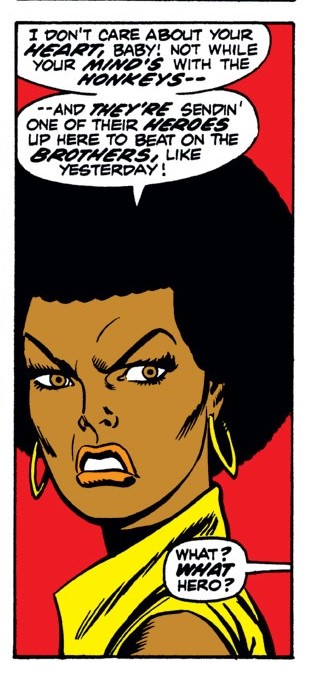 Sam goes to investigate and finds Cap, who seems a little out of sorts....and a lot racist......  He is able to unmask the imposter, but it is Steve Rogers' face, under the hood. Sam is stunned mentally, then is stunned physically, from behind and awakens to the sight of....  They beat Falcon up and haul him off to interrogate him about where the "phony Captain America" is, while spouting as close as Code-approved comics got to racial slurs. Some kids witness this and go get help from Raife, Sam's rival and the local militant gang leader. he doesn't care about an "Uncle Tom," like Sam, but others stand up for what the Falcon has done for the neighborhood and a posse is formed, to find Falcon and the two red, white & blue honkeys. They track him down to a warehouse, where "Cap" is beating on the bound Falcon, when one of the group does the old "Candy-Gram for Mongo".....  The group attacks "Cap & Bucky" and give Falcon time to get free and join the fight. "Cap" runs off with the unconscious "Bucky" and Sam tells the group thanks. He tries to track the phonies down, without success, and decides he needs to alert Steve Rogers, who is in the sunny Caribbean. He goes to Avengers Mansion and, after passing Jarvis' security check, talks to the Avengers and asks them to keep an eye out for the phonies, while he alerts the real Cap. Vision enters the room and says "Cap" just relieved him on monitor duty and they rush in to find him gone. In the sunny Bahamas, Steve and Sharon frolic on the beach, when Steve spots someone who looks like Bucky. He gives chase and is Pearl harbored, by "Cap & Bucky." 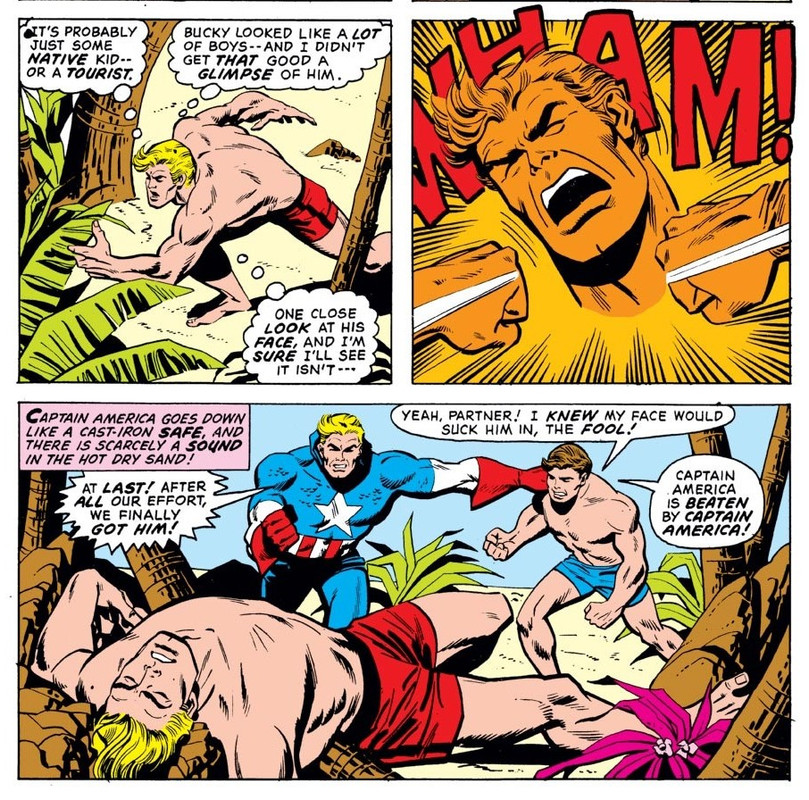 They go after Sharon, but Falcon arrives and intercedes, then the pair fight the phonies, but go down. All 3 become the captives of the phonies. This being a comic book, Fake Cap starts to monologue and tells us of Cap's #1 member of the Sentinels of Liberty..... 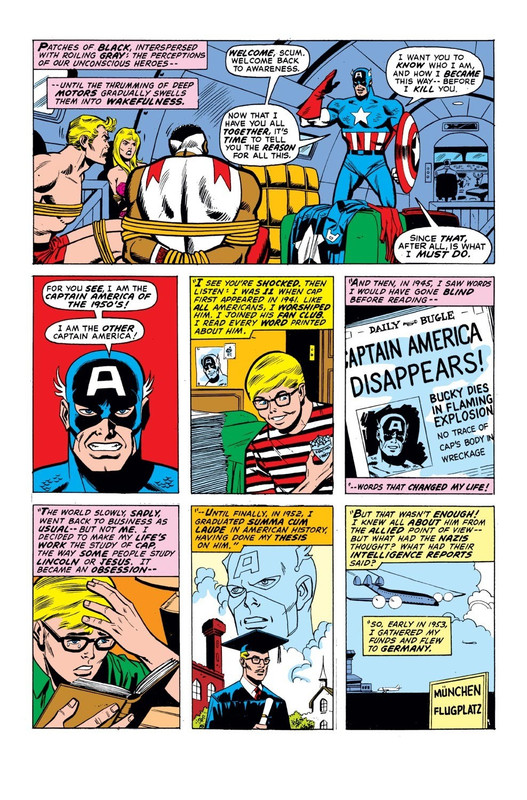 In 1953, he flew to Munich to examine the old Nazi archives and found references to Captain America, then a report from an Abwehr agent, who had infiltrated Operation: Rebirth and stolen the secret of the Super-Soldier Formula, before being discovered and killed. He took the information to the government, who were anxious to have it in Korea, but he refused to divulge it unless he was the new Cap. After proving it worked and a background check found him clean, the government agreed. He was surgically altered to look like Steve Rogers. However, with the truce in Korea, the government backed off and cancelled the plans. The man returned to teaching, at a school, where he noted a fellow Cap devotee, in one of the boys. He told the lad he was the real Cap, and that the papers were wrong. The kid believed, but others didn't, because he seemed to young. After hearing that the Red Skull was back, and had kidnapped UN delegates, they decide to prove that they are the real deal and inject themselves with the formula... 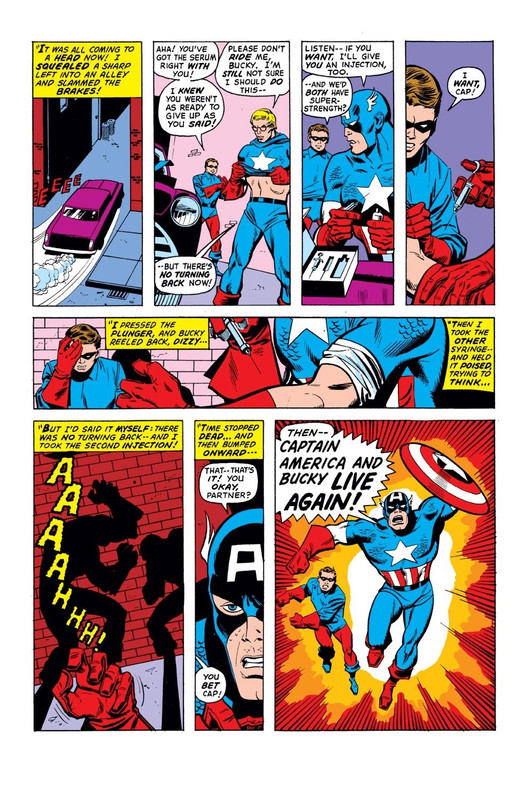 They defeat the "Red Skull, " who was a Commie who stole the name, plus other Red agents, like Electro (different guy) and the Man With No Face (a Red Chinese assassin). They then found more Commies, among the non-"pure blooded Americans," in Harlem and Watts. The government takes notice and calls them in and the official who dealt with them before tells them that their research leads them to believe that the formula is unstable, without the Vita-Rays. They tell them to turn themselves in for treatment and "Cap" flips him the American Eagle and starts to walk out. The Feds zap them and lock them up, in stasis tubes.... 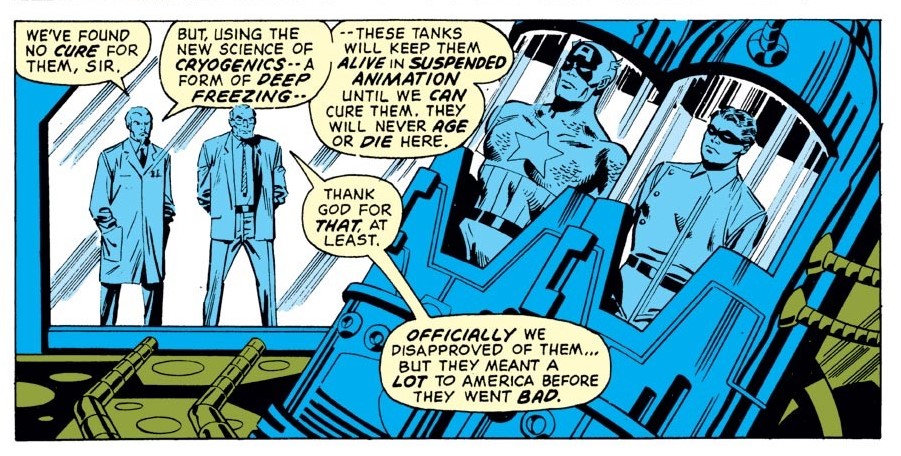 Time passed and when Nixon started fostering Detente, with the Soviets and Chinese, a "Right-Thinking American" among the men watching over them, released them from stasis....  Cap storms off, after finishing his story and Steve tosses off his ropes (he was free all through storytime) and frees the others. He suits up and goes after 50s Cap & Bucky. They wait until the phonies land their seaplane, in the US and attack. The battle rages over Miami and climaxes in front of the Torch of Friendship, on Biscayne Blvd. Cap prevails and the fake goes back into cold storage, as does the fake Bucky, after Falcon cold-cocks him. 50s Cap would return, under the mind-manipulation of Dr Faustus, as the Grand Director of the fascist National Force, in Captain America #231-236.       Peggy Carter finds Cap and alerts him that Sharon is in danger and it is related to White Supremacist rallies, of the National Front. We see the Grand Director speak to a crowd, them incite them to hatred and violence. It turns out, he is being manipulated by Dr Faustus, the Nazi psychologist and mind programming expert. 50s Cap & Bucky had been brought to a mental instituition, in the Catskills, that was a front for The Corporation, a criminal empire, who had sprung Faustus to aid them. He reprogrammed Cap, then had him kill Bucky. He then set in motion a plan to test and then release a hate gas, on New York, which included briefly controlling the real Cap... 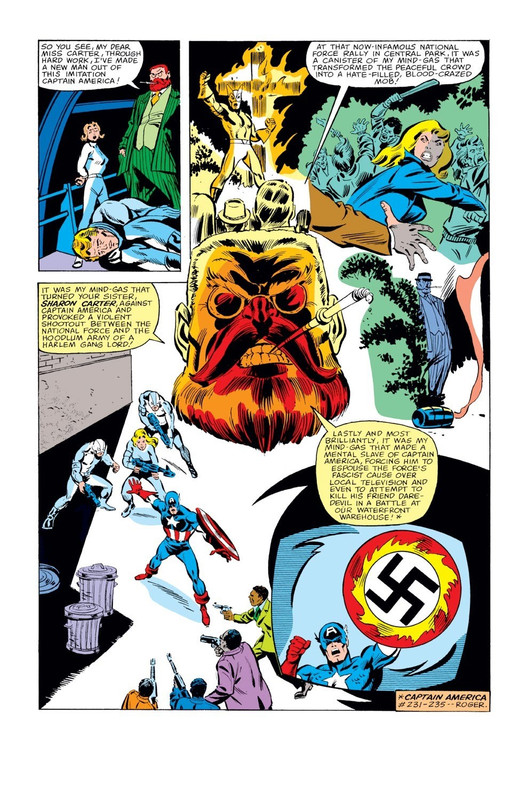 The Grand Director is torn between the Nazi Dr Faustus and the real Cap and activates his self immolation device. He got better. Ed Brubaker brought him back, still under the control of Faustus and the Red Skull, who kept him under suspended animation, until his body healed from his wounds (even though we saw him burnt to ashes, in Cap #236). He is programmed to attack New Cap, aka Bucky Barnes, but is eventually defeated by Original Cap, after he has joined the Watchdogs terror group and gotten into more trouble. His death is faked and he is told by Cap that he is relieved of his duty, to heal ,and that it is the serum, not him, that caused the problems. Brubaker gave him the name William Burnside. Fake Bucky reappears in Cap #281 and gains the name Jack Monroe and that he wasn't killed by Burnside, and that the pistol we saw shoot Bucky had blanks.   Monroe is successfully treated and becomes the new Nomad, Steve Rogers former identity, after quitting as Cap (in Marvel's version of Watergate). He sticks around for a bit, in Captain America, then makes guest appearances, before getting his own mini, where he starts using a shotgun and cares for a little kid, who he calls Bucky and carries around in a backpack carrier, like a bad version of Lone Wolf and Cub. That led to a series, but it didn't last long, after Clarke Hawbaker left the art. He dies at the end of his series, but gets better and ends up in suspended animation, again, and ends up programmed to be the new Scourge, in Thunderbolts. He is freed of that and then killed off by Ed Brubaker. Sucks to be him. Now, Roy sort of alludes to Englehart's retcon, in What If...? #4, by mentioning that the Daily Bugle incorrectly informed the public that Cap disappeared and was believed dead, somewhere over the North Sea. This headline is seen in Cap #155 and it was Roy's way of handling the discrepancy between what Englehart did in Captain America and what he was doing in What If...?. Then, that kept getting compounded by later writers, whenever they trotted Burnside and Monroe out to play. One of the interesting things is that Sal Buscema carried forward the conceit that 50s Cap only had vertical red and white stripes on the front of his tunic, as did Dick Purcell, in the Captain America movie serial, from Republic. However, that was not Republic being cheap. In Captain America Comics #2, Cap is distinctly shown as standing in a 3/4 view, with no stripes on the back of his tunic. This carried on through the run of the comics and was continued during the brief revival. When Cap is reborn, in the Marvel Universe, the stripes go all the way around his torso. Thus, using the old Timely costume design (except for the helmet, from his first appearance, they could differentiate the 50s Cap and Marvel Cap. Englehart also explained away the Commie Red Skull, seen in the 50s, as a phony, using the name. Originally, he was used because Cap had no other recurring foe. The fact that Communism and Fascism are polar opposites in ideology had no bearing on the stories.  Captain America Annual #6 acts as a sort of coda, to Roy's retcon, as well as Englehart's, as William Naslund, Jeff Mace, William Burnside and Steve Rogers, as Cap, are brought to an alternate reality by The Contemplator, aka Mr Buddha, to stop an alternate Adam II. It was here we learned of Mace retiring, connecting him to the dawn of Burnside, in 1953...sort of. Burnside saw the Daily Bugle story and took it for granted, but didn't seem to know of the others. Englehart's story was part of a great run, which included this, plus Cap fighting the Secre Empire and giving up the rle to become Nomad, after the president is exposed as part of The Secret Empire. Sal Buscema is the artist, which made for a somewhat bulkier Cap. Buscema & Don Perlin handle the art for the National Front storyline and Mike Zeck was the artist when Jack Monroe returned and became Nomad. Roger McKenzie wrote the National Front material and JM Dematteis handled the return of Monroe. Ed Brubaker and Steve Epting did the more recent era work on the characters, though I can't recall if there were any other artists working on the Brubaker stories, with Burnside. I'm sure someone will add that info if I missed it. So, that was Cap, between what was retconned in Avengers #4 and Englehart and Thomas' later retcons, and what happened to those alternates, later. Jeff Mace is facing cancer, in the Captain America Annual and, in Captain America #285, succumbs to it....  Next, a look at what the Sub-Mariner was up to, between 1946 and 1962. |
|
|
|
Post by mikelmidnight on Feb 20, 2024 12:16:35 GMT -5
Well, he could have kept the Spirit of '76 until the 1950s Cap, right? There were no valid reasons to have him killed. Oh well, it's not important  Thanks for the explanation! Valid? No; just Roy's need to stick to the chronology of the published comics. He wanted The Patriot, since he was a Timely character, relatively popular, and a logical choice. However, since he still had his own series going, until 1946, Roy felt bound by that and needed someone in between, especially someone who could have a shocking death. He could have stuck with the Spirit and killed him off in 1949; but, he still wanted to use The Patriot.. Thanks for the explanation, it sort of makes sense in an ADD sort of way. I personally hated the move, because (a) it makes the Patriot's own career and 'legend' sort of an afterthought, and (b) because Cap 2 and Cap 3 are ... basically the same person anyway? Non-powered formerly flag-costumed hero, filling in for Steve Rogers. It felt redundant, just to have a death because, you know, What If. |
|
|
|
Post by tarkintino on Feb 20, 2024 14:12:17 GMT -5
Steve Englehart's 1950s Cap & Bucky retconning / backstory was one of the greatest of all Captain America tales. The title was always at its best when Cap's own history (direct or associated) and the sociopolitical narratives of his life (or reaction to it) continued to define Marvel's most historic superhero (the times and experiences of his "two-part" life-story) making him a richer character in and out of costume. Englehart crafted a wonderful, rare example of joining two distinct superhero publishing eras into a relatively tight, coherent, single history. I'm not certain Marvel ever topped this kind of retconning Golden Age heroes, with the last, best examples predating it found in Avengers #4 (1964), and arguably Fantastic Four Annual #4 (1966) and Sub-Mariner #14 (1969), the latter two dealing with the original Human Torch.
|
|
|
|
Post by codystarbuck on Feb 21, 2024 18:43:02 GMT -5
In 1961, Martin Goodman's often-renamed company decided to try superheroes, again, since the competition seemed to be doing well with them and Martin was nothing, if not an imitator. Whether or not the impetus came from a game of golf with the owners of the other side or not is the stuff of legends; but, what is clear is that they launched The Fantastic Four, possibly with old monster material tossed into the mix, possibly recycling Jack Kirby's old Challenger's of the Unknown, possibly by swiping from Jack Cole's Plastic Man and possibly whatever Stan said in whichever interview that wasn't fact checked (most of them). I'm not rekindling that debate here. What is abundantly clear was that it didn't take long for Marvel (whoever had the idea) to revive some of those old Timely Era characters. They had already swiped the name and gimmick of the Human Torch from the original android; but, this time, they decided to use the actual guy: Namor, the Sub-Mariner. Of course, they first had to settle whether it was pronounced Sub-Mareener or Sub-Mariner, like The Rhyme of the Ancient Mariner; or, if it was pronounced Throatwobbler Mangrove! ( tmMonty Python) So, as we know, The Human Torch stormed off after the defeat of the Miracle Man, because Ben called him a sissy or something. The team went to look for him (after Reed bawled out Ben) and Ben finds him working on his hot rod. Ben smashes the wall of the garage and tosses the car at Johnny, after he taunts him and Johnny flies off. He tries to lose himself in the Bowery, which Kirby makes look like it was about 40 years before. Johnny needs a place to stay and goes to a cheap men's hotel (basically a flop house, except you get a bed instead of hanging on a rope stretched across the room) and he settles in for the night and reads an old, discarded Sub-Mariner comic, because there were comics done about real people, in the Marvel Universe, aside from those done by Dell and Treasure Chest of Fun and Fact, and the like.  Some guy sees Johnny reading the comic and says there is a dude there who is as strong as the Sub-Mariner was supposed t be and starts hassling a scruffy looking guy, who just wants to sleep. The jerk taunts him to tear a telephone book in half and he refuses; so everyone gangs up on him, because why should he be left alone when a mob can try to bully him? Said mob gets tossed around like dolls and they grab weapons and prepare for round 2, until Johnny gets involved. Johnny can see the guy is ill and seems to have lost his memory and tries to calm the crowd; but, they want blood. He appeases them by using his flame to scorch off hair until we get the startling revelation.....  He is the Sub-Mariner. Johnny flames on, picks him up and carries him off to the ocean and drops him in the water, to revive his memory. Luckily, he is Namor, the Sub-Mariner and not Leonard Nimoy, so he doesn't drown. He then discovers that Atlantis has been destroyed and he forgets all about being allies with the Surface World and vows revenge. He summons up a massive monster and Ben has to play Jonah and climb inside it's mouth, with a nuke strapped to his back. After giving it an atomic heartburn, they fight Subby, until he sees Sue materialize and we learn about where the issue title comes from. Johnny conjures up a whirlwind and dumps Namor back into the ocean. Subby would come back to play with the FF again, first in a tag-team with Doctor Doom; but they were booked to lose and Subby blamed Doom. Eventually, he found his people, attacked the surface world, stopped other Atlanteans from attacking and had his own adventures in Tales to Astonish (or at least Tales to Raise the Eyebrow) In the very last issue, Namor, tired after fighting the Hulk, is plagued by voices and mental images. He is lured to the Antarctic and finds a lost civilization, and a dude with a funky hat....  This dude would end up answering the question that fans had asked, since 1932: What happened between Namor's last comic book appearance and FF #4? Well, Roy Thomas was going to tell us! First though, he had to pick up the story where it left off, from Archie Goodwin, in a special bridging issue for Iron Man & Sub-Mariner, because their new titles weren't ready for them to move in (they had to finish the wall paper and fix the leaky faucet in the kitchen and repaint the kitchen cabinets). Namor resumes his confrontation with the man who calls himself Destiny. He mentions that they have fought before, but Namor has no memory. 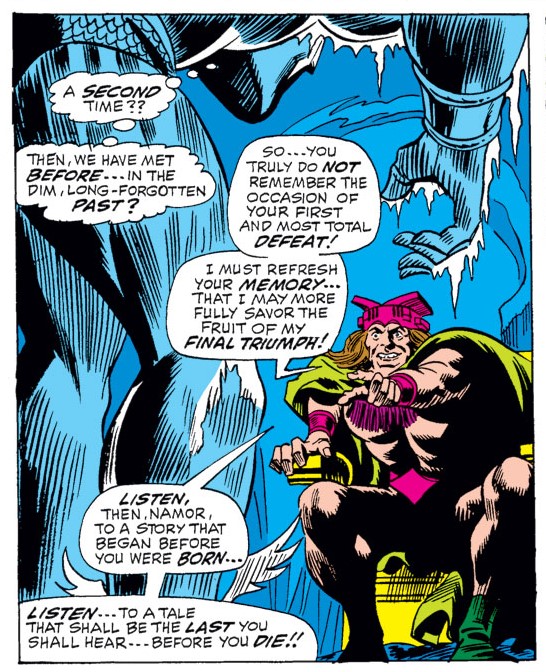 We learn that Destiny worked as a carnival mind reader, Mentallo (not the guy who hung out with The Fixer), but was the real deal. He found out about an ancient race of people who had tremendous mental powers and a note about a possible location in Antarctica. He signed aboard the ice breaker Oracle, and persuaded the captain, Leonard MacKenzie, to stop and search for the remains of this civilization. Namor sees the images of Destny's mind and his father and Destiny locating the lost city and an amazing power soure. destiny is greedy and Capt MacKenzie tries to stop him, that no one man should control such power and Destiny causes an avalanche. Namor breaks free of the mental control and they fight. Now, we jump ahead to Subby's new book, after he has unloaded all of the boxes and moved all of the furniture around. Namor is trapped under the ice and he thinks back about his father and Roy takes us back through Subby's origin, as Captain Leonard MacKenzie and his crew plant charges to break up icebergs and cause shocks in Atlantis, below the surface.Emperor Thakorr sends his daughter, Princess fenn, and a hand-picked band of warriors, to find out what is causing the quakes. She finds the Oracle and MacKenzie and they fall in love and do a bit of "ice-breaking" themselves. Thak is a bit worried, sends troops to look for his daughter and they try to take her back by force, which leads to a fight and MacKenzie's death. Fenn returns to Atlantis, with a surprise for Daddy. Namor grows to hot-headed manhood and attacks the surface world and battles the Human Torch. However, when the Nazis attack Atlantis, he joins the Allies in the fight and battles Nazi u-boats in the Atlantic and Japanese aircraft, in the Pacific. After the war ends, he hangs out for a bit fighting criminals, as there is no one else to fight, but grows tired of it and returns home.  Atlantis suffers massive quakes, again, and Namor goes to find the source and ends up meeting Destiny, who attacks him and takes control of his motor functions. He continues his attack on Atlantis and Thak and fenn are crushed when the palace collapses, under the attack. Namor is helpless to save his mother and Destiny sends him flying off, against his will, his memory stolen from him. Namor arrives in New York, with no memory of who he is or where he coems from. He stumbles onto a fur heist and is attacked by the thieves, but Namor layeths the smackdown on them. He decides he needs to look like the other men, to hide out, while he tries to emember who he is.... 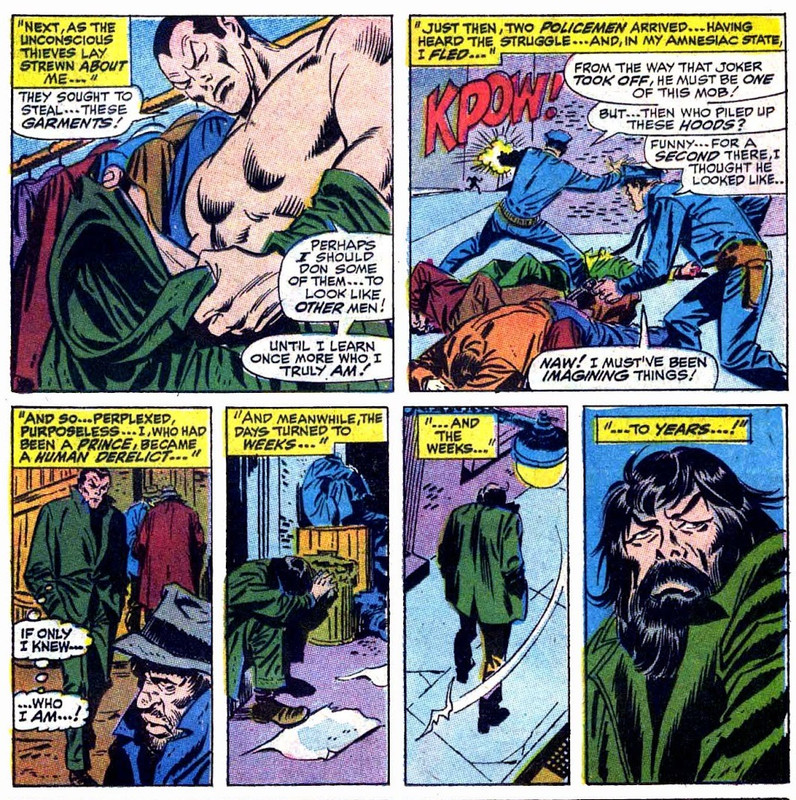 He ends up in the men's hotel and meets Johnny Storm and we are back to where we started. In 1988, Roy (and wife Dann) revisited Namor, with the 12-issue maxi-series, The Saga of the Sub Mariner.     He retells Namor's life story, with a bit of expansion and embellishment, starting with the Atlanteans and the sinking of Atlantis, after they have survived the Deviants of Lemuria bringing war to the Celestial Host. Atlantis is torn apart and sinks under the sea. Eventually, its ruins are discovered by a mer race, who claim them for their own cities and a new Atlantean civilization is born. In 1920, the SS Oracle, an ice-breaker, seeking the Endurance, Eernest Shackleton's doomed ship from his 1915 expedition. on board is Paul Destine, the man who had been Mentallo and would later rechristen himself Destiny. Roy retells of their meeting and expands upon it, as Fenn learns to communicate with Capt. MacKenzie and he falls for her beauty. She reports back and get Pop's okay to continue living with the crew and learning of the surface dweller's ways. She and Leonard fall in love and they marry. Leonard is unaware that Fenn must continuously take an elixir to breath out of the water and on their honeymoon night, he speaks of returning to California, with his new bride. She fears what wil happen, but stays with her husband. He leaves her briefly, to travel with Destine to search for this lost civilization and the pair find it, but Destine causes an avalanche and MacKenzie barely escapes alive. He finds his new wife, who had been weker before he left, in even worse shape, as her elixir is nearly gone. he wants to take her to hospital but she begs him to stay where they are and Emperor Thakorr ends up sending his warriors to find his daughter. She returns, after the unfortunate death of her husband, pregnant. At the end of the first issue, she gives birth to Namor, a hybrid with caucasian human skin tone. The series continues through a turbulent childhood, marked with a rivalry between Namor and Prince Byrrah, the heir to the throne. He also meets surface men. He goes to see the world of his father and gets into all kinds of trouble, in New York and throws massive temper tantrums, until police woman Betty Dean is assigned to try to meet with Namor and calm him down. She spots him in the water, jumps in an pretends to be drowning and Namor saves her. 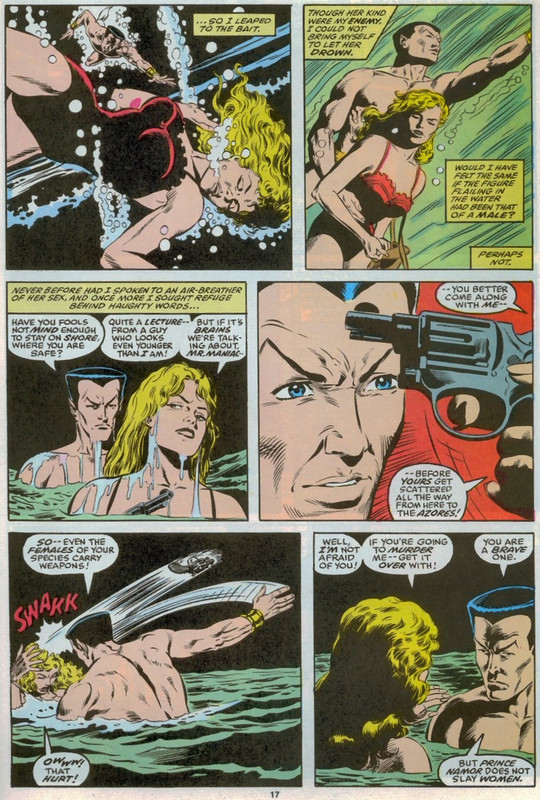 She then tries to arrest him and he swats away her pistol. She is defiant and he likes her spirit. They witness a British merchant ship being torpedoed by a Nazi u-boat and Namor is unfazed, but Betty rails at him about the war and his own violence. She tells him of Germany and their thirst for conquest, in contrast to America (with their own thirst for economic conquest, but not so much against white people). He swims out and destroys the sub and returns to aid Betty. Others act hostile towards him and he responds in kind, but not towards Betty. Since Betty didn't work out, the police chief sends out The Human Torch, leading to their big battles 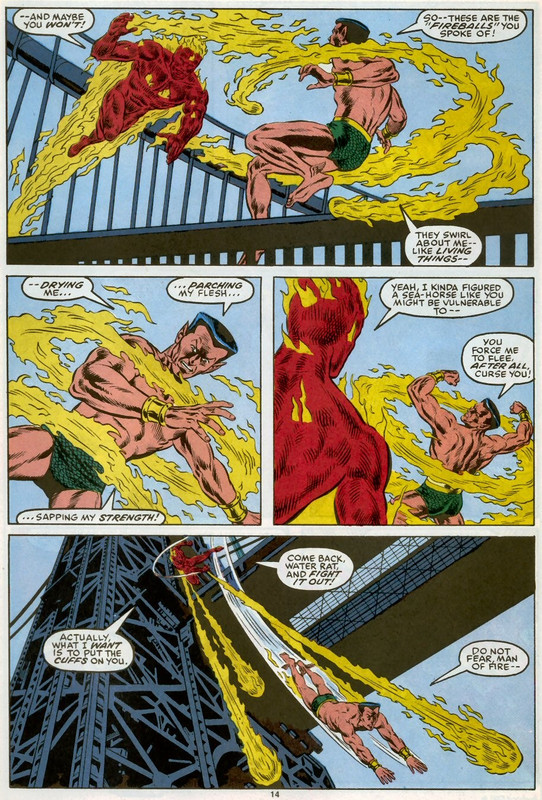 Namor gets the better of the Torch in their first fight and Torch reports back and finds the chief arguing with Betty about Namor. he sides with the chief and goes off to battle Namor agaain and gets himself trapped in a glass tube, slowly suffocating, until Betty intercedes and offers to broker a truce between the US and Atlantis, if Namor will free the Torch. Torch agrees to help and Namor decides he will trust them, because of Betty. Hitler sends his u-boats to conquer Atlantis, after learning of its existence, leading to a war between Germany and the Atlanteans, led by Namor. Namor meets with the Torch and pledges that Atlantis and he will aid the Allies, against the Axis powers. He joins Torch and Captain America in founding The Invaders. He fights alongside them and is there when President Truman asks them to remain together, after the death/disappearance of Captain America, as the All-Winners Squad. he reports back to his people and finds that the emperor has recovered from his injuries, inflicted by the Nazis, and Byrrah has orchestrated Namor's banishment, for "abandoning" Atlantis.  Namor is stopped from creating a civil war, by his mother, who convinces him that only blood will result and Dorma might be hurt in the fighting. namor accepts his banishment and heads away, until Thakorr comes to his senses, with Fenn's urging and counsel. Namor returns, later, at invitation, but finds that surface criminals, in search of Atlantis' treasures, have attacked the emperor. namor and his cousin namora return to the surface world to extract justice, with the aid of Betty Dean. Namor's ankle wings wither away and he becomes less powerful, a situation which worries the emperor and Namor is subjected to an experiment with rejuvinates his strength and he regrows the wings. He is sent as an emissary to the UN, but a misunderstanding leads to fear and anger. Namor then is plagued by a voice in his head and is drawn to Antarctica, where he runs into Paul Destine, now calling himself Destiny. The rest of the series mostly sticks to the established stories, with minor continuity fixes or an expansion of a scene, for more logical motivation. The series itself was a 50th anniversary celebration for Namor and it would lead to other things, including the new series, from John Byrne. That will be a topic down the road. The series has a back page where Roy reprints a conversation, from Alter Ego, wit Bill Everett. At one point, he mentions that one of the young fans of the new Sub-Mariner, was a kid named Jack Lemmon, whose mother was a close friend of Everett's cousin. Roy later sent some Sub-Mariner comics to Lemmon, who recalled both the Sub-Mariner and Amazing Man, the hero that Everett created for Centaur. With the conclusion of the Saga of the Sub-Mariner, Roy turned to retelling the Saga of The Human Torch. He will be our next subject, as we learn what happened to him, after the war and the 1950s and his reappearance in the Marvel universe, to discover that someone has appropriated his name. |
|
|
|
Post by codystarbuck on Feb 27, 2024 0:46:41 GMT -5
After being put to bed, in 1954, superheroes returned to Marvel, in the form of the Fantastic Four, in 1961. Granted, bets were hedged by making them adventurers, in the mode of the monster comics and Kirby's Challengers of the Unknown, rather than the costumed mystery men of the 1940s. Well, until they got costumes in issue #3. Even then, it was more of an organizational uniform, rather than a flashy solo costume. Bets were further hedged with a relatively well-known name, in The Human Torch. Instead of bringing back the original android Human Torch, his name and powers were transformed to teenager Johnny Storm, making him a sort of combination of Torch and his sidekick, Toro (in a similar fashion to how Julie Schwarz had been reviving old DC hero names, with new characters, giving both something familiar and something new). As we saw, Namor, the Sub-Mariner, and co-star of Marvel Comics #1, made his return in issue #4. The third star, The Angel, would have to wait a while to even get someone to use his name. Captain America returned in Avengers #4, in 1964. Someone, possibly Stan, possibly Jack, maybe even Irving Forbush, though it was a good idea to bring back Jim Hammond, the Original Human Torch and have him meet the upstart. That meeting would take place, in Fantastic Four King Size Special #4 (as they called it back then, but everyone calls Annual #4).  Ben, Reed and Sue are sitting around a table, reading the mail, when Ben comes across a letter asking about the original Human Torch and Ben acts ignorant of the hero who was well known to citizens of New York City, in the 1940s, not to mention Allied soldiers, during the war. Reed clues him in, when they are interrupted by the arrival of Johnny, Wyatt Wingfoot and the Inhuman canine, Lockjaw. Johnny has been trying to get past a Negative Zone barrier, blocking off Attilan, in the Himalayas. Johnny whines a bit, while they give Lockjaw a big tub of milk, which leads to an energy burst and a ruined carpet, if you know what I mean. Elsewhere, The Thinker, the mad inventor, has found something he has been feverishly looking for and he is quite happy.... 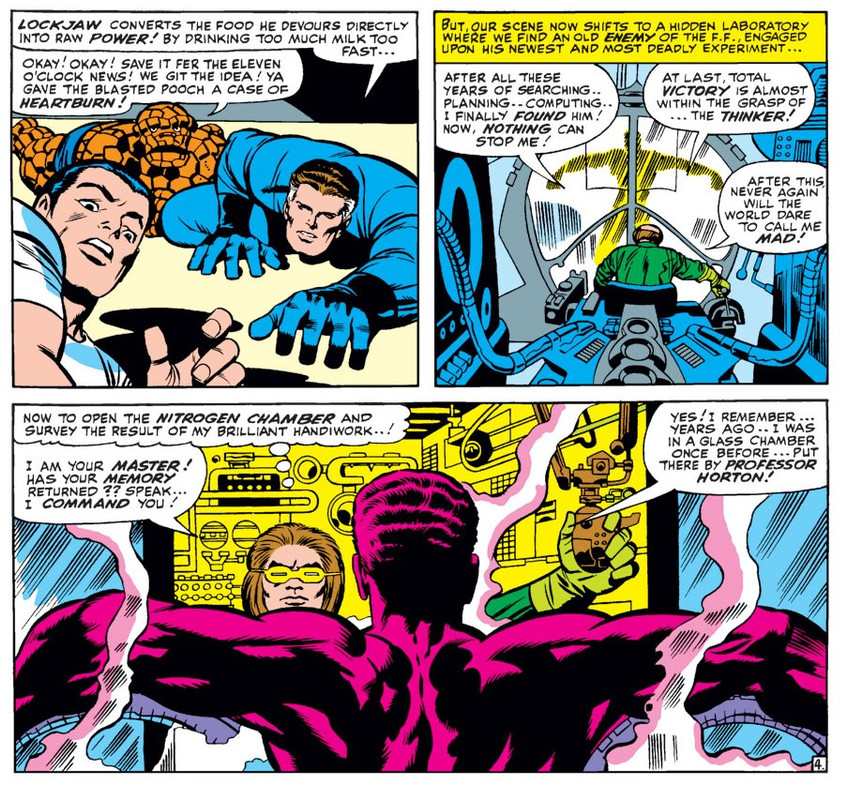 The discovery is the first android, the Human Torch, the creation of Professor Phineas Horton. The Torch recalls his unveiling, by Prof Horton and his bursting into flame, leading his creator to bury him underground, as a failure 9and for safety). The Torch burned his way to freedom. However, he has no memory beyond that and the Thinker likes it that way. He deludes the Torch into believing that he solved the spontaneous combustion problem, so he is in the Thinker's complete control. The Thinker then dispatches him for a destructive assignment. Johnny flies off tot he desert to experiment with bringing his heat ot nova levels, to try to burn through the barrier around Attilan. While he is heating up, he is attacked by a tornado.... 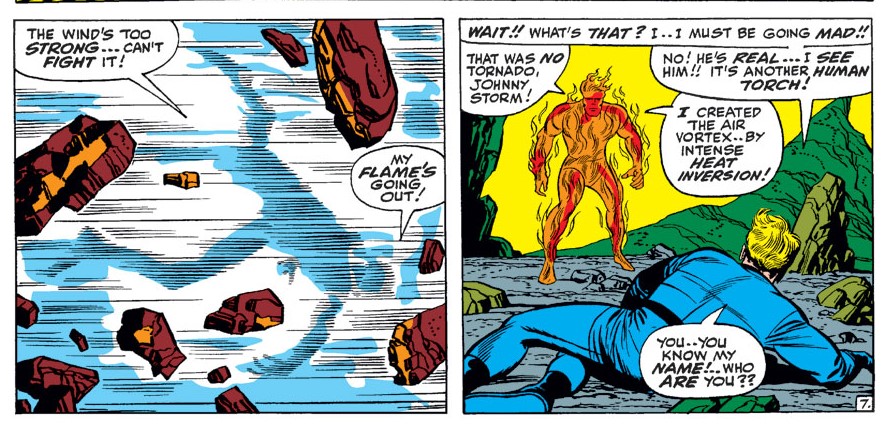 Johnny asks who the flaming character is and he introduces himself as the original human Torch. Then, it is ON! 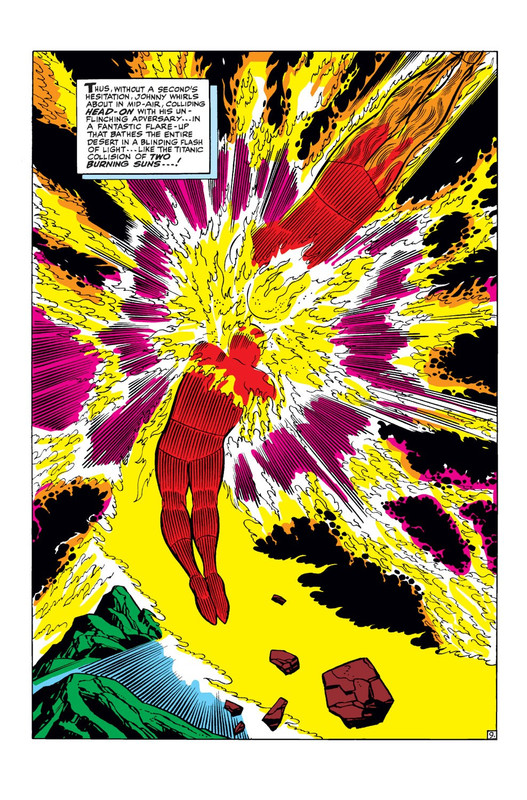 The generate so much heat, they melt boulders and Johnny burns through the ground, to caverns below. His flame goes out, his energy spent and the original soon follows, with the same result. Johnny Pearl Harbors Jim Hammond, but, he's been around the block before and recovers quickly and relights his pilot light for more fun. Johnny finds a match and restarts his own and they are black to flaming each other. The intense heat cause cracks in the cavern floor, releasing a pocket of natural gas and.... 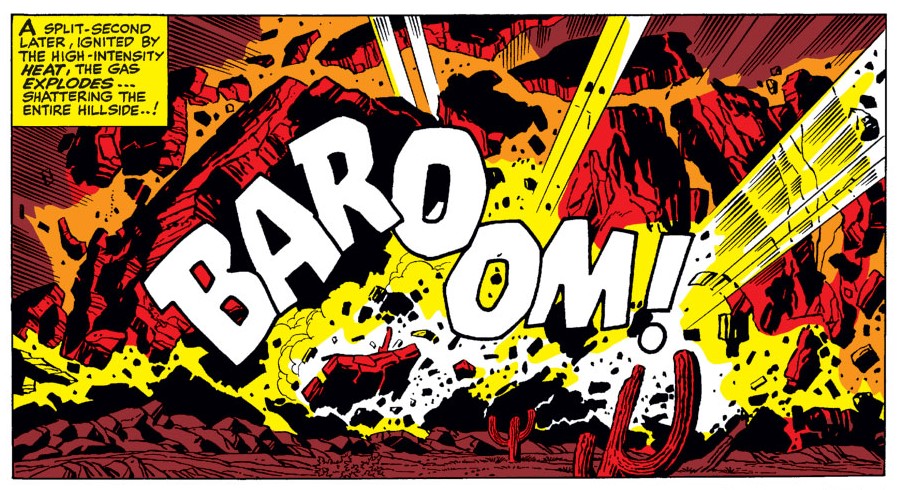 There is an interlude of the thinker arguing with his computer, Quasimodo ( a euphemism of Quasi-Motivational Destruct Organ, which makes little sense), who wants to be a real "boy" (or android, as it were); but Thinker isn't having it. He says to have the destruct cell ready, in case Hammond fails. During the fight, Hammond lets slip, about the Thinker and Johnny tries to convince him to team up, but he is reluctant. The rest of the FF arrive, thanks to Lockjaw, and Reed subdues Hammond, with a "liquid asbestos gel solution,' which will give everyone respiratory diseases in about 20 years. They use Lockjaw to key in on Hammond's brainwaves and teleport them to the Thinker's lair. The Thinker activates Quasimodo and Hammond flames up and destroys himself, reverting to android form and seeming to be "dead." The ending is a bight anti-climactic and resets the status quo. Torch remained "dead," for a bit, until Roy Thomas created The Vision, using the name and a sort of likeness to the original Timely character. he established that Ultron 5 created the Vision, using the android body of The Human Torch, and the brain patterns of the dead Wonder Man. Steve Englehart, in his build up to the Celestial Madonna, revealed how it was done, with Ultron finding the body, where the Thinker and the FF left it, and he gets past Quasimodo to steal it. He then finds a drunken, sad Phineas Horton, who has been reduced to repairing tvs and forces him to revise his creation into The Vision, with Ultron guiding him. A little bit later, Roy established that Horton had created Adam II and John Byrne then takes up the idea of the true origin of The Vision, in West Coast Avengers. Meanwhile, Sub-Mariner #14 gave us a new chance to see Namor battle his old nemesis, The Human Torch....  Namor is in the Pacific and runs into frightened fish and a lot of dead fish. He goes up to investigate and is attacked by the Human Torch. he can't understand why Johnny Storm is attacking and fights back, but gets overpowered and the Torch says it has been 2 decades since they last saw each other.... 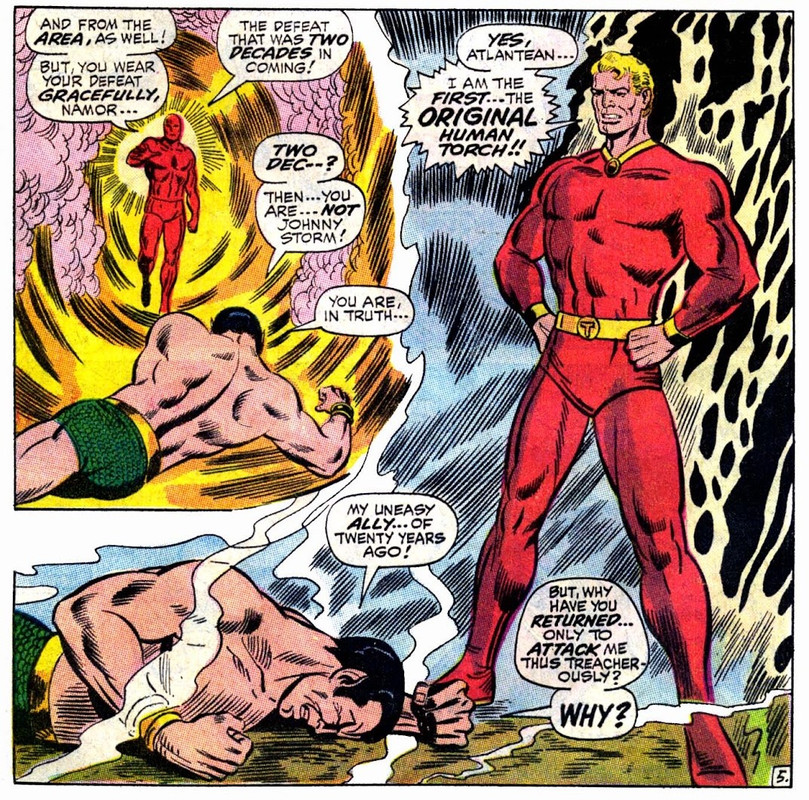 Torch calls into the Thinker, who appears to be back in control of him (even though he is "dead") and Namor learns that the Torch's collar is keeping him in the Thinker's control. Namor gets to the water and revitalizes his strength and Thinker throws a hissy fit, made worse by the Puppet Master's kibbitzing, and destroys his radio mic, preventing him from giving the Torch orders. Namor hits him with a wall of water and is able to subdue him and demands to know how the Thinker is controlling him. He relates how the Thinker is in league with The Puppet Master and Egghead and he sends out the Torch to activate a volcano and create destruction, as a test, to bring America to its knees, if it proves successful. Torch leads Namor to the dormant volcano, where Thinker has his HQ and they get zapped, but fight on, together, and defeat the Thinker and smash his machine. Torch's flame grows more intense, out of control and Namor uses a piece of metal shielding to remove him from the area and get him to the water, which cools him off and changes his hair color to brown. Then, Namor learns the true identity of The Torch.... 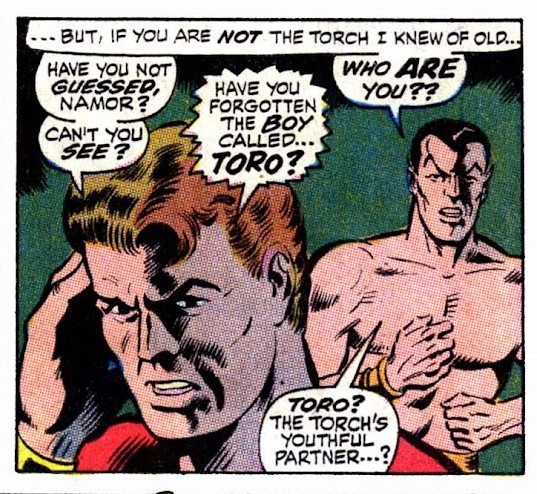 Toror Raymond! Toro relates that he retired in 1956, married in 1966 and read about the Torch's demise. He was then met by The Thinker, who slipped him a mickey and brainwashed him into believing he was the Torch, to then carry out his plan. The Thinker tries to escape and Toro intercepts a weapon, then crashes into the Thinker's ship, which is destroyed, taking him with it. Like Namor, The Torch got a 50th Anniversary mini-series, from Roy Thomas and Rich Buckler, recounting his history.     It retells old stories and retcons, while refining things. Issue one deals with his birth and first adventures, while #2 follows the wartime saga. Issue 3 continues the retcon of Torch killing Adolf Hitler, though Buckler perpetuates Frank Robbins' error of Hitler trying to shoot himself in the head with a Luger P08, instead of a Walther PPK. It continues with the All-Winners Squad and Torch's late 40s adventures, including Toro going off and being replaced by Sun Girl. He then sees the death of his creator; but, it was a fake by the government, who has seized all of Horton's notes, because his androids are too dangerous. The bitter professor goes off to start a new life. Torch meets up with Toro again and then runs afoul of some gangsters and gets buried out in the desert. Issue #4 picks up with his burning his way out, crossing through a nuclear test and going off to fight the Korean War. The gangster reveals that he sold Toro to the Russians and they meet in battle, and Torch wins and takes the injured Toro for treatment. They fight more Commies and hoods, then Torch's flame gets out of control and he sends Toror away, then buries himself deep in the Earth, where he is located by The Thinker. That would be it for The Human Torch, until John Byrne starts p[laying around with things, in West Coast Avengers and then in his new Namor series. That run of issues will be our next subject. |
|
|
|
Post by Rob Allen on Feb 27, 2024 13:02:28 GMT -5
After being put to bed, in 1954, superheroes returned ... A quibble - Cap and the Torch went away in '54 but the Sub-Mariner series lasted until October 1955. There were apparently some serious negotiations for a Sub-Mariner TV series going on, and Goodman kept publishing the comic to keep the character in the public eye. |
|
|
|
Post by chaykinstevens on Feb 28, 2024 17:40:07 GMT -5
I wonder whose idea it was to colour Adam II's face that way, contrary to how Frank Springer had inked it. |
|


























 Thanks for the explanation!
Thanks for the explanation!




















































